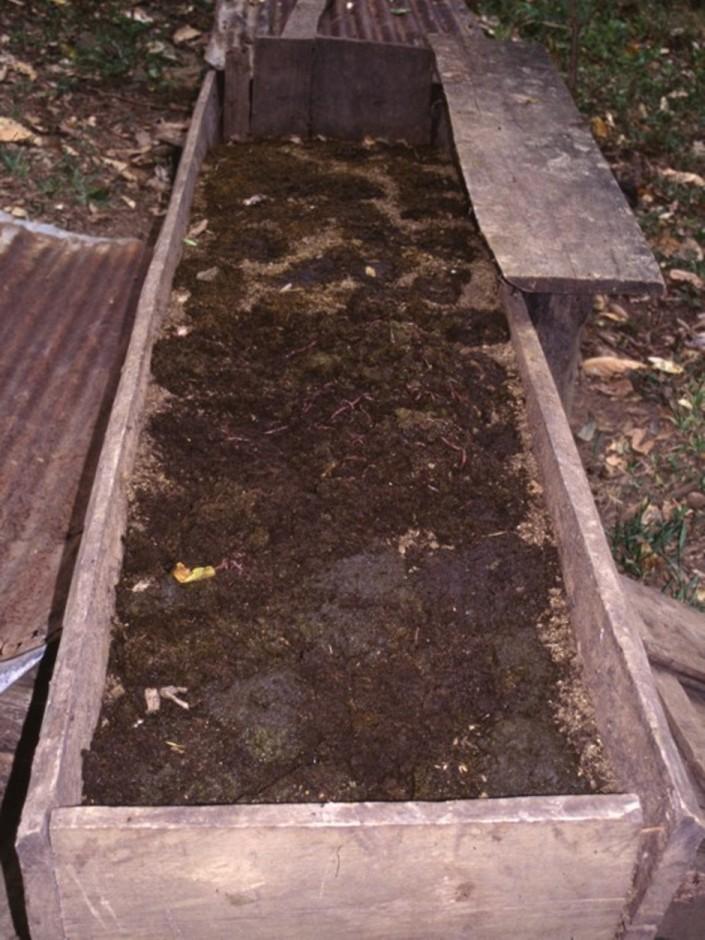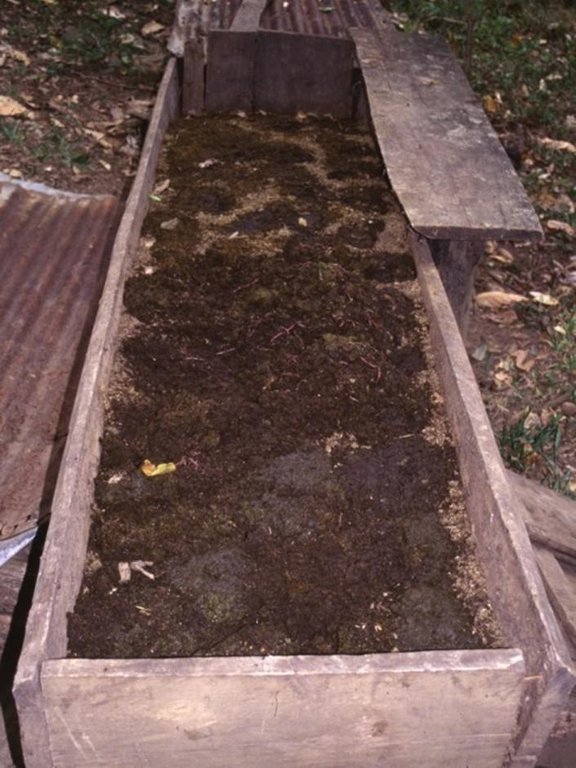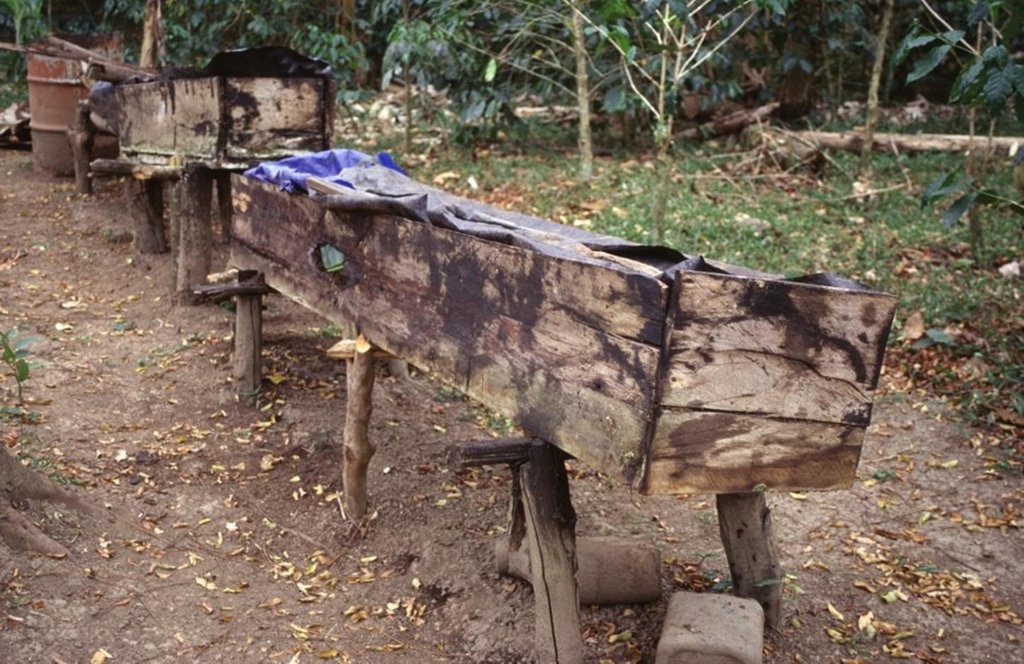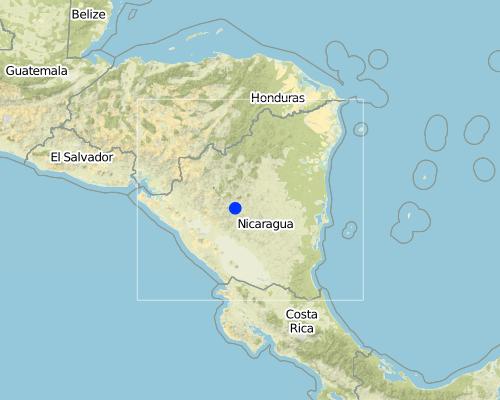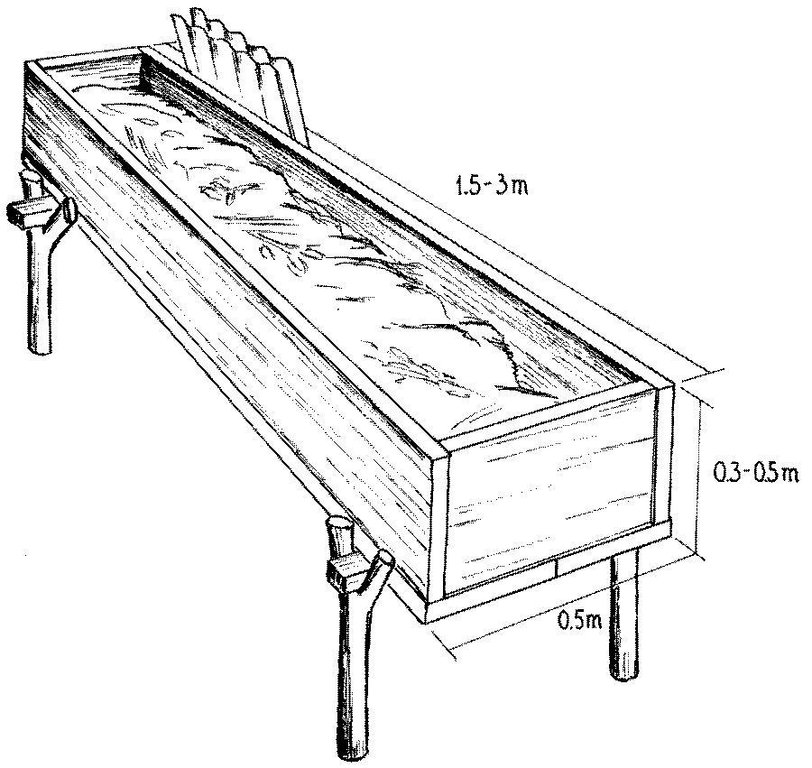Vermiculture [นิการากัว]
- ผู้สร้างสรรค์:
- การอัพเดท:
- ผู้รวบรวม: Mathias Gurtner
- ผู้เรียบเรียง: –
- ผู้ตรวจสอบ: Deborah Niggli
Lombricultura
technologies_1022 - นิการากัว
ดูส่วนย่อย
ขยายทั้งหมด ย่อทั้งหมด1. ข้อมูลทั่วไป
1.2 รายละเอียดที่ติดต่อได้ของผู้รวบรวมและองค์กรที่เกี่ยวข้องในการประเมินและการจัดเตรียมทำเอกสารของเทคโนโลยี
ผู้เชี่ยวชาญ SLM:
Gómez Martínez Julio César
De ENITEL
3c al Norte y 75 varas al Este. Calle Santa Ana
นิการากัว
ชื่อของโครงการซึ่งอำนวยความสะดวกในการทำเอกสารหรือการประเมินเทคโนโลยี (ถ้าเกี่ยวข้อง)
Book project: where the land is greener - Case Studies and Analysis of Soil and Water Conservation Initiatives Worldwide (where the land is greener)1.3 เงื่อนไขการใช้ข้อมูลที่ได้บันทึกผ่านทาง WOCAT
วันที่เก็บรวบรวมข้อมูล(ภาคสนาม) :
01/02/2004
ผู้รวบรวมและวิทยากรหลักยอมรับเงื่อนไขเกี่ยวกับการใช้ข้อมูลที่ถูกบันทึกผ่านทาง WOCAT:
ใช่
1.4 การเปิดเผยเรื่องความยั่งยืนของเทคโนโลยีที่ได้อธิบายไว้
เทคโนโลยีที่ได้อธิบายไว้นี้เป็นปัญหาของความเสื่อมโทรมโทรมของที่ดินหรือไม่ จึงไม่ได้รับการยอมรับว่าเป็นเทคโนโลยีเพื่อการจัดการที่ดินอย่างยั่งยืน:
ไม่ใช่
2. การอธิบายลักษณะของเทคโนโลยี SLM
2.1 การอธิบายแบบสั้น ๆ ของเทคโนโลยี
คำจำกัดความของเทคโนโลยี:
Continuous breeding of earthworms in boxes for production of high quality organic compost.
2.2 การอธิบายแบบละเอียดของเทคโนโลยี
คำอธิบาย:
Vermiculture is a simple and cheap way to produce a continuous supply of organic compost of high quality. Eisenia foetida, the Red Californian earthworm (also called ‘the red wiggler’) is ideal for vermiculture since it is adapted to a wide range of environmental conditions. Under culture, the worms are kept under shade, in long wooden boxes filled with earth, cattle manure and an absorbent material (eg straw). The box is covered by sheet metal (or wood, thick plastic sheeting, or banana leaves) to protect the worms against UV radiation and birds/chickens, and also to maintain a favourably humid microclimate. Fresh cattle manure is a perfect food for the worms, but rotten coffee pulp can also be fed. Chopped crop residues (eg cowpeas, leucaena leaves or other legumes) may be added.
The compost produced by the earthworms has a dark colour, no smell and a loose and spongy structure. It is a high value, high quality product which is very rich in nutrients, and in a form that makes them readily available to vegetation. The content of a full box can be harvested every 3-4 months, and is used for crops -mainly coffee and vegetables, but also maize and beans. It is very effective in increasing soil fertility and thus crop production. It also improves soil structure, infiltration and water storage capacity.
The compost can either be applied directly to coffee, mixing it with an equal amount of earth and applying 1 kg to each plant. Alternatively it can be sprayed: for preparation of liquid fertilizer 50 kg compost are mixed with 50 litres of water and left to soak for 5 days. The concentrated solution produced is mixed with water at a ratio of 1 to10 and applied to the crop using a knapsack sprayer. The earthworms reach their reproductive age after three months and live for many years. In perfect conditions an earthworm produces up to 1,500 offspring per year. Thanks to their rapid reproduction, new cultures can easily be established, or earthworm stocks can be sold according to the farmer’s needs. A certain amount
of earthworm compost is kept back and being used instead of fresh earth to reinitiate the whole process, or to start new cultures.
The area is characterised by humid climate, steep slopes and low soil fertility. Farmers are mainly smallholders with individual properties. Earthworm culture does not depend closely on the external environment, but it is essential to maintain favourable conditions inside the box - namely continuous feeding and wetting. That’s why it is usually recommended to keep cultures near the house and the home-garden. Ants, the main enemy of earthworms, can be controlled standing the boxes on poles in cans filled with water.
2.3 รูปภาพของเทคโนโลยี
2.5 ประเทศภูมิภาค หรือสถานที่ตั้งที่เทคโนโลยีได้นำไปใช้และได้รับการครอบคลุมโดยการประเมินนี้
ประเทศ:
นิการากัว
ภูมิภาค/รัฐ/จังหวัด:
Matagalpa
ข้อมูลจำเพาะเพิ่มเติมของสถานที่ตั้ง :
Matiguas, Pancasán
Map
×2.7 คำแนะนำของเทคโนโลยี
ให้ระบุว่าเทคโนโลยีถูกแนะนำเข้ามาอย่างไร:
- ทางโครงการหรือจากภายนอก
3. การจัดประเภทของเทคโนโลยี SLM
3.1 วัตถุประสงค์หลักของเทคโนโลยี
- รักษาสภาพหรือปรับปรุงความหลากหลายทางชีวภาพ
3.2 ประเภทของการใช้ที่ดินในปัจจุบันที่ได้นำเทคโนโลยีไปใช้

พื้นที่ปลูกพืช
- การปลูกพืชล้มลุกอายุปีเดียว
- การปลูกพืชยืนต้นที่ไม่มีเนื้อไม้
แสดงความคิดเห็น:
Major land use problems (compiler’s opinion):
- low crop yields due to soil fertility decline
- water and wind erosion
- small landholdings
3.3 ข้อมูลเพิ่มเติมเกี่ยวกับการใช้ที่ดิน
การใช้น้ำของที่ดินที่มีการใช้เทคโนโลยีอยู่:
- จากน้ำฝน
จำนวนของฤดูเพาะปลูกต่อปี:
- 1
ระบุ:
Longest growing period in days: 300, Longest growing period from month to month: May untill February
3.4 กลุ่ม SLM ที่ตรงกับเทคโนโลยีนี้
- การจัดการความอุดมสมบรูณ์ของดินแบบผสมผสาน
- การเลี้ยงผึ้ง การเพาะเลี้ยงสัตว์น้ำ สัตว์ปีก ฟาร์มกระต่าย ฟาร์มหนอนไหม
3.5 กระจายตัวของเทคโนโลยี
แสดงความคิดเห็น:
Total area covered by the SLM Technology is 5 m2.
3.6 มาตรการ SLM ที่ประกอบกันเป็นเทคโนโลยี

มาตรการจัดการพืช
- A4: การรักษาดินชั้นล่าง
แสดงความคิดเห็น:
Type of agronomic measures: manure / compost / residues
3.7 รูปแบบหลักของการเสื่อมโทรมของที่ดินที่ได้รับการแก้ไขโดยเทคโนโลยี

การเสื่อมโทรมของดินทางด้านเคมี
- Cn (Fertility decline): ความอุดมสมบูรณ์และปริมาณอินทรียวัตถุในดินถูกทำให้ลดลงไป (ไม่ได้เกิดจากสาเหตุการกัดกร่อน)
แสดงความคิดเห็น:
Main causes of degradation: soil management, deforestation / removal of natural vegetation (incl. forest fires), overgrazing (on a single cattle farm), poverty / wealth (lack of capital)
Secondary causes of degradation: over-exploitation of vegetation for domestic use, other natural causes (avalanches, volcanic eruptions, mud flows, highly susceptible natural resources, extreme topography, etc.) specify (impacts of hurricane Mitch), governance / institutional (lack of strenght of law and authorities), inter-generational subdivision of land
3.8 การป้องกัน การลดลง หรือการฟื้นฟูความเสื่อมโทรมของที่ดิน
ระบุเป้าหมายของเทคโนโลยีกับความเสื่อมโทรมของที่ดิน:
- ลดความเสื่อมโทรมของดิน
4. ข้อมูลจำเพาะด้านเทคนิค กิจกรรมการนำไปปฏิบัติใช้ ปัจจัยนำเข้า และค่าใช้จ่าย
4.1 แบบแปลนทางเทคนิคของเทคโนโลยี
4.2 ข้อมูลจำเพาะด้านเทคนิคและการอธิบายแบบแปลนทางเทคนิค
Detailed view of wooden box for compost production by earthworms. Cover (corrugated iron or alternative) is important to protect worms from light, from birds and other natural enemies, and to maintain moisture in the box.
Technical knowledge required for field staff / advisors: moderate
Technical knowledge required for land users: moderate
Main technical functions: increase of surface roughness, improvement of topsoil structure (compaction), increase in organic matter, increase in nutrient availability (supply, recycling,…)
Secondary technical functions: increase of infiltration
Manure / compost / residues
Material/ species: compost
4.5 ค่าใช้จ่ายของปัจจัยนำเข้าที่จำเป็นสำหรับการจัดตั้ง
| ปัจจัยนำเข้า | หน่วย | ปริมาณ | ค่าใช้จ่ายต่อหน่วย | ค่าใช้จ่ายทั้งหมดต่อปัจจัยนำเข้า | %ของค่าใช้จ่ายที่ก่อให้เกิดขึ้นโดยผู้ใช้ที่ดิน | |
|---|---|---|---|---|---|---|
| แรงงาน | labour | ha | 1.0 | 6.0 | 6.0 | 100.0 |
| วัสดุสำหรับก่อสร้าง | wood | ha | 1.0 | 50.0 | 50.0 | 100.0 |
| วัสดุสำหรับก่อสร้าง | Sheet metal, plastic | ha | 1.0 | 6.0 | 6.0 | 100.0 |
| อื่น ๆ | earthworms (kg) | ha | 1.0 | 60.0 | 60.0 | |
| ค่าใช้จ่ายทั้งหมดของการจัดตั้งเทคโนโลยี | 122.0 | |||||
แสดงความคิดเห็น:
Duration of establishment phase: 0.07 month(s)
4.6 การบำรุงรักษาสภาพหรือกิจกรรมที่เกิดขึ้นเป็นประจำ
| กิจกรรม | ประเภทของมาตรการ | ช่วงระยะเวลา/ความถี่ | |
|---|---|---|---|
| 1. | 1. Feeding: add another layer of cattle manure(1 kg earthworms eat 1 kg manure per day). | จัดการพืช | no specific timing for maintenance / every 3–5 days |
| 2. | 2. Maintain humidity at 80%, water frequently in dry season, maintaintemperature between 15–30°C: do not exceed 42°C. | จัดการพืช | no specific timing for maintenance / frequently in dry season |
| 3. | 3.The worms migrate into the fresh manure. After 2–3 days take out thesieve and gather the ready, worm free compost. | จัดการพืช | no specific timing for maintenance / every 3–4 months |
| 4. | 4. Apply compost to the crops (1 kg/coffee plant, see description). | จัดการพืช | no specific timing for maintenance / every 3–4 months |
| 5. | 6. Possible improvement: add lime to raise pH to a optimum level of 7.0. | จัดการพืช | no specific timing for maintenance / |
4.7 ค่าใช้จ่ายของปัจจัยนำเข้าและกิจกรรมที่เกิดขึ้นเป็นประจำที่ต้องการการบำรุงรักษา (ต่อปี)
| ปัจจัยนำเข้า | หน่วย | ปริมาณ | ค่าใช้จ่ายต่อหน่วย | ค่าใช้จ่ายทั้งหมดต่อปัจจัยนำเข้า | %ของค่าใช้จ่ายที่ก่อให้เกิดขึ้นโดยผู้ใช้ที่ดิน | |
|---|---|---|---|---|---|---|
| แรงงาน | labour | ha | 1.0 | 60.0 | 60.0 | 100.0 |
| ค่าใช้จ่ายทั้งหมดของการบำรุงรักษาสภาพเทคโนโลยี | 60.0 | |||||
แสดงความคิดเห็น:
Machinery/ tools: hammer, nails, buckets/wheelbarrow, shovel, possibly water hose, hammer, nails, buckets/wheelbarrow, shovel, possibly water hose
60% of the land users have their own cattle, others get manure free from their neighbours. The cattle manure has no commercial price in the region - there is no market for it. The inputs and costs are estimated for the production of approx. 4,000 kg of worm compost, which is enough for one hectare of coffee per year (note figures from India for vermiculture suggest higher input-output ratios: in other words less output for the same amount of input).
5. สิ่งแวดล้อมทางธรรมชาติและของมนุษย์
5.1 ภูมิอากาศ
ฝนประจำปี
- < 250 ม.ม.
- 251-500 ม.ม.
- 501-750 ม.ม.
- 751-1,000 ม.ม.
- 1,001-1,500 ม.ม.
- 1,501-2,000 ม.ม.
- 2,001-3,000 ม.ม.
- 3,001-4,000 ม.ม.
- > 4,000 ม.ม.
เขตภูมิอากาศเกษตร
- ชื้น
- กึ่งชุ่มชื้น
Thermal climate class: tropics
5.2 สภาพภูมิประเทศ
ค่าเฉลี่ยความลาดชัน:
- ราบเรียบ (0-2%)
- ลาดที่ไม่ชัน (3-5%)
- ปานกลาง (6-10%)
- เป็นลูกคลื่น (11-15%)
- เป็นเนิน (16-30%)
- ชัน (31-60%)
- ชันมาก (>60%)
ธรณีสัณฐาน:
- ที่ราบสูง/ที่ราบ
- สันเขา
- ไหล่เขา
- ไหล่เนินเขา
- ตีนเนิน
- หุบเขา
ระดับความสูง:
- 0-100 เมตร
- 101-500 เมตร
- 501-1,000 เมตร
- 1,001-1,500 เมตร
- 1,501-2,000 เมตร
- 2,001-2,500 เมตร
- 2,501-3,000 เมตร
- 3,001-4,000 เมตร
- > 4,000 เมตร
5.3 ดิน
ค่าเฉลี่ยความลึกของดิน:
- ตื้นมาก (0-20 ซ.ม.)
- ตื้น (21-50 ซ.ม.)
- ลึกปานกลาง (51-80 ซ.ม.)
- ลึก (81-120 ซ.ม.)
- ลึกมาก (>120 ซ.ม.)
เนื้อดิน (ดินชั้นบน):
- ละเอียด/หนัก (ดินเหนียว)
อินทรียวัตถุในดิน:
- ต่ำ (<1%)
5.6 ลักษณะของผู้ใช้ที่ดินที่นำเทคโนโลยีไปปฏิบัติใช้
แนวทางการตลาดของระบบการผลิต:
- เพื่อการยังชีพ (หาเลี้ยงตนเอง)
- ผสม (การเลี้ยงชีพ/ทำการค้า)
รายได้ที่มาจากนอกฟาร์ม:
- < 10% ของรายได้ทั้งหมด
ระบุลักษณะอื่นๆที่เกี่ยวข้องของผู้ใช้ที่ดิน:
Off-farm income specification: nearly all land users are fully occupied with agricultural activities, very few are involved in commerce or are employed
5.7 พื้นที่เฉลี่ยของที่ดินที่เป็นเจ้าของหรือเช่าโดยผู้ใช้ที่ดินที่นำเทคโนโลยีไปปฏิบัติใช้
- < 0.5 เฮกตาร์
- 0.5-1 เฮกตาร์
- 1-2 เฮกตาร์
- 2-5 เฮกตาร์
- 5-15 เฮกตาร์
- 15-50 เฮกตาร์
- 50-100 เฮกตาร์
- 100-500 เฮกตาร์
- 500-1,000 เฮกตาร์
- 1,000-10,000 เฮกตาร์
- >10,000 เฮกตาร์
5.8 กรรมสิทธิ์ในที่ดิน สิทธิในการใช้ที่ดินและสิทธิในการใช้น้ำ
กรรมสิทธิ์ในที่ดิน:
- รายบุคคล ไม่ได้รับสิทธิครอบครอง
- รายบุคคล ได้รับสิทธิครอบครอง
สิทธิในการใช้ที่ดิน:
- เช่า
- รายบุคคล
6. ผลกระทบและสรุปคำบอกกล่าว
6.1 ผลกระทบในพื้นที่ดำเนินการ (On-site) จากการใช้เทคโนโลยี
ผลกระทบทางด้านเศรษฐกิจและสังคม
การผลิต
การผลิตพืชผล
การผลิตพืชที่ใช้เลี้ยงปศุสัตว์
คุณภาพพืชที่ใช้เลี้ยงปศุสัตว์
รายได้และค่าใช้จ่าย
รายได้จากฟาร์ม
ผลกระทบด้านสังคมวัฒนธรรมอื่น ๆ
การบรรเทาความขัดแย้ง
ผลกระทบด้านนิเวศวิทยา
ดิน
ความชื้นในดิน
แสดงความคิดเห็น/ระบุ:
through improvement of soil water storage capacity
ความหลากหลายทางชีวภาพของพืชและสัตว์
การจัดการศัตรูพืชและโรคพืช
แสดงความคิดเห็น/ระบุ:
the compost attracts pests like ants, chickens, moles
6.2 ผลกระทบนอกพื้นที่ดำเนินการ (Off-site) จากการใช้เทคโนโลยี
การเกิดมลพิษในน้ำบาดาลหรือแม่น้ำ
แสดงความคิดเห็น/ระบุ:
lower inputs of chemical fertilizers
6.5 การปรับตัวของเทคโนโลยี
แสดงความคิดเห็น:
88 land user families have adopted the Technology with external material support
6 land user families have adopted the Technology without any external material support
There is a little trend towards spontaneous adoption of the Technology. As ADDAC (the Association for Agricultural Community Development and Diversification) has a permanent and longterm presence in the approach area, most interested farmers are directly involved in the programme activities: this explains the fact that only 5% of the technology users (6 people) took up earthworm culture without incentives (see approach).
6.7 จุดแข็ง / ข้อได้เปรียบ / โอกาสของเทคโนโลยี
| จุดแข็ง / ข้อได้เปรียบ / โอกาสในทัศนคติของผู้ใช้ที่ดิน |
|---|
| Additional economic income through commercialization of earthworm stocks |
| Health: clean products without chemical treatment. |
| จุดแข็ง / ข้อได้เปรียบ / โอกาสในทัศนคติของผู้รวบรวมหรือวิทยากรหลัก |
|---|
| Continuous and increasing production of organic and very effective compost with high nutrient content (replacing chemical fertilizers) |
|
Appropriate for different crops (though in different forms – direct application or spraying). |
| Simple and cheap technology; low labour input |
| Increased crop yields |
| Earthworm culture is becoming an integrated part of the production system, especially for land users who have cows. |
6.8 จุดอ่อน / ข้อเสียเปรียบ / ความเสี่ยงของเทคโนโลยีและวิธีการแก้ไข
| จุดอ่อน / ข้อเสียเปรียบ / ความเสี่ยงในทัศนคติของผู้รวบรวมหรือวิทยากรหลัก | มีวิธีการแก้ไขได้อย่างไร |
|---|---|
| Requires permanent access to water | A close fitting and secure box cover, as well as placement of the box in the shade reduces loss of humidity. Roof-top rainwater collection helps to get over dry periods. |
| Requires continuous availability of manure to feed worms. | Improve the construction of the boxes (close holes and cover the box tightly). |
| Attracts natural enemies like ants, chickens, moles, flies; needs protection |
7. การอ้างอิงและการเชื่อมต่อ
7.1 วิธีการและแหล่งข้อมูล
- ไปเยี่ยมชมภาคสนาม การสำรวจพื้นที่ภาคสนาม
- การสัมภาษณ์กับผู้ใช้ที่ดิน
7.2 การอ้างอิงถึงสิ่งตีพิมพ์
หัวข้อ, ผู้เขียน, ปี, หมายเลข ISBN:
PASOLAC. Guía Técnica de Conservación de Suelos y Agua.. 2000.
ชื่อเรื่อง ผู้เขียน ปี ISBN:
PASOLAC, Managua
หัวข้อ, ผู้เขียน, ปี, หมายเลข ISBN:
Ferruzzi C. Manual de Lombricultura. Ediciones Mundi-Prensa. Madrid, Spain. 1986.
หัวข้อ, ผู้เขียน, ปี, หมายเลข ISBN:
Castillo H . La lombricultura. in Altertec. Alternativas de Mejoramiento de Suelos.Proceso de Capacitación para Profesionales. Modulo II. Altertec, Ciudad de Guatemala. 1994.
ลิงก์และโมดูล
ขยายทั้งหมด ย่อทั้งหมดลิงก์
ไม่มีลิงก์
โมดูล
ไม่มีโมดูล


